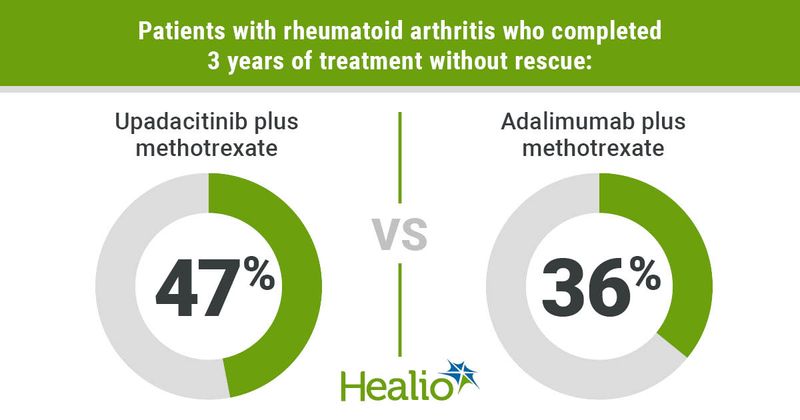Upadacitinib maintains higher RA clinical response vs. adalimumab through 3 years
Upadacitinib continues to maintain higher levels of clinical response, compared with adalimumab, in patients with rheumatoid arthritis through 3 years, according to data presented at the EULAR 2021 Virtual Congress.
The results come from a long-term extension of the SELECT-COMPARE study, in which researchers previously concluded that 15 mg of upadacitinib (Rinvoq, AbbVie) daily, alongside methotrexate, demonstrated improved signs and symptoms in patients with RA, compared with adalimumab (Humira, AbbVie) and methotrexate co-therapy through 72 weeks.

“SELECT-COMPARE is a phase 3 study in patients with active rheumatoid arthritis and an inadequate response to methotrexate, in which the Janus kinase inhibitor upadacitinib, 15 mg once daily on background methotrexate, demonstrated statistically significant improvements in the clinical manifestations of RA, when compared to adalimumab plus methotrexate at week 12,” Roy Fleischmann, MD, of the Metroplex Clinical Research Center, at the University of Texas Southwestern Medical Center, in Dallas, said during a poster session at the meeting.
“Significant improvement in favor of upadacitinib versus adalimumab were maintained through 72 weeks,” he added.

To analyze the long-term safety and efficacy of upadacitinib during a 3-year period, compared with adalimumab, Fleischmann assessed data from the ongoing SELECT-COMPARE long-term extension. In the initial study, patients with RA and an inadequate response to methotrexate were randomized to receive with 15 mg of upadacitinib daily, 40 mg of adalimumab every other week, or placebo. In total, 651 participants were treated with upadacitinib and 327 received adalimumab, while 651 were placed in the placebo group. All participants received background methotrexate.
Between weeks 14 and 26, participants received rescue therapy for either lack of response or failure to achieve the target disease outcome, which was defined as CDAI low disease activity at week 26. Those who completed the 48-week double-blind period were eligible to enter the long-term extension for a total of up to 10 years of treatment.
For this analysis, Fleischmann and colleagues assessed data through 3 years of treatment, including treatment-emergent adverse events and events of special interest. The researchers analyzed efficacy based on the original randomized groups. Those who were rescued or discontinued their study drug early were considered “non-responders” for visits following the rescue or withdrawal. The researchers used descriptive analysis without formal statistical comparisons.
According to the researchers, 39% of participants were rescued from upadacitinib to adalimumab, while 49% were rescued from adalimumab to upadacitinib, between weeks 14 and 26. All patients in the placebo group were switched to upadacitinib by week 26. In the long-term extension, 47% of participants randomized to upadacitinib completed 3 years without rescue, compared to 36% of those randomized to adalimumab.
In addition, greater proportions of participants randomized to upadacitinib demonstrated low disease activity and remission at 3 years based on CDAI, as well as DAS28(CRP) scores of 3.2 or less, or less than 2.6, compared with those randomized to receive adalimumab.
Regarding safety, upadacitinib was “generally well-tolerated” based on rates of treatment-emergent adverse events, the researchers wrote. This included serious adverse events, adverse events leading to discontinuation and events of special interest, as well as serious and opportunistic infections, malignancies, adjudicated major adverse cardiac events or venous thromboembolism. Rates of adverse events of special interest were generally comparable between the upadacitinib and adalimumab groups, although herpes zoster, lymphopenia, hepatic disorder and creatine phosphokinase elevation were reported at higher rates in the upadacitinib group.
“Over a 3-year period, upadacitinib plus methotrexate continued to show numerically better clinical responses, including rates of remission and low disease activity, compared to adalimumab plus methotrexate,” Fleischmann said. “The safety of upadacitinib was generally similar to adalimumab, with the exception of higher rates of herpes zoster, lymphopenia, hepatic disorder and CPK elevation, which were reported at higher rates with upadacitinib.”
“Upadacitinib’s safety profile was consistent with the results reported previously in SELECT-COMPARE and with the integrated phase 3 safety analysis,” he added. “In this study — which was not primarily designed to show safety differences — rates of deaths, malignancies, MACE and VTEs were overall similar on upadacitinib and adalimumab with background methotrexate therapy.”

